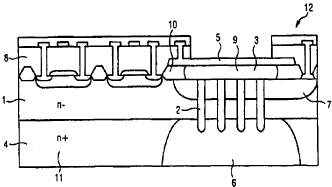Some of the information on this Web page has been provided by external sources. The Government of Canada is not responsible for the accuracy, reliability or currency of the information supplied by external sources. Users wishing to rely upon this information should consult directly with the source of the information. Content provided by external sources is not subject to official languages, privacy and accessibility requirements.
Any discrepancies in the text and image of the Claims and Abstract are due to differing posting times. Text of the Claims and Abstract are posted:
| (12) Patent: | (11) CA 2340059 |
|---|---|
| (54) English Title: | MICROMECHANICAL SENSOR AND METHOD FOR PRODUCING SAME |
| (54) French Title: | CAPTEUR MICROMECANIQUE ET SON PROCEDE DE PRODUCTION |
| Status: | Deemed expired |
| (51) International Patent Classification (IPC): |
|
|---|---|
| (72) Inventors : |
|
| (73) Owners : |
|
| (71) Applicants : |
|
| (74) Agent: | FETHERSTONHAUGH & CO. |
| (74) Associate agent: | |
| (45) Issued: | 2003-12-23 |
| (86) PCT Filing Date: | 1999-08-03 |
| (87) Open to Public Inspection: | 2000-02-24 |
| Examination requested: | 2001-02-09 |
| Availability of licence: | N/A |
| (25) Language of filing: | English |
| Patent Cooperation Treaty (PCT): | Yes |
|---|---|
| (86) PCT Filing Number: | PCT/DE1999/002375 |
| (87) International Publication Number: | WO2000/009440 |
| (85) National Entry: | 2001-02-09 |
| (30) Application Priority Data: | ||||||
|---|---|---|---|---|---|---|
|
The invention relates to a micromechanical sensor and to a corresponding
production method, comprising the following steps: a) preparing a doped
semiconductor wafer (4); b) applying an epitaxial layer (1) that is doped in
such a way that a jump in the charge carrier density in the interface (11)
between the semiconductor wafer and the epitaxial layer occurs; c) optionally
etching ventilation holes (2) traversing the epitaxial layer and optionally
filling the ventilation holes with a sacrificial material; d) depositing at
least one sacrificial layer (9), at least one spacing layer (10), a membrane
(5) and optionally a semiconductor circuit (8) on the top side of the
epitaxial layer using a technology known per se, wherein the semiconductor
circuit may be applied after the membrane is formed or while depositing the
layers required to form the membrane; e) etching a hole (6) on the back part
of the sensor, wherein the etching method is selected in such a way that
etching advances in the direction of the top side and ceases in the interface
between the wafer (4) and the epitaxial layer (1) by changing charge carrier
concentration. The invention also relates to the utilization of the
micromechanical sensor in pressure sensors or microphones.
L'invention concerne un capteur micromécanique et son procédé deproduction, lequel comprend les étapes suivantes: a) préparationd'une tranche de semi-conducteur (4) dopée; b) application d'unecouche épithaxiale (1) qui est dopée de façon telle qu'à l'interface (11) entre la tranche de semi-conducteur et la couche épitaxiale se présente une discontinuité dans la densité des porteurs de charge; c) éventuellement, création par attaque d'ouvertures deventilation (2) qui traversent la couche épitaxiale et, éventuellement, remplissage des ouvertures de ventilation avec un matériau sacrificiel; d) application d'au moins une couche sacrificielle (9), d'au moins une couche d'espacement (10), d'une membrane (5) et, éventuellement, d'un circuit à semi-conducteur (8), selon une technologie connue en soi, sur la face supérieure de la couche épitaxiale, le circuit à semi-conducteur pouvant être appliquéaprès formation de la membrane ou pendant l'application des couches nécessaires à la formation de la membrane; e) création par attaque d'une ouverture (6) sur la face arrière du capteur, le procédé d'attaque étant choisi de façon telle que le processus d'attaque se produise en direction de la face supérieure et s'arrête à l'interface entre la tranche (4) et la couche épithaxiale (1) parmodification de la concentration des porteurs de charge. L'invention concerne également l'utilisation du capteur micromécanique dans des capteurs de pression ou dans des microphones.
Note: Claims are shown in the official language in which they were submitted.
Note: Descriptions are shown in the official language in which they were submitted.

For a clearer understanding of the status of the application/patent presented on this page, the site Disclaimer , as well as the definitions for Patent , Administrative Status , Maintenance Fee and Payment History should be consulted.
| Title | Date |
|---|---|
| Forecasted Issue Date | 2003-12-23 |
| (86) PCT Filing Date | 1999-08-03 |
| (87) PCT Publication Date | 2000-02-24 |
| (85) National Entry | 2001-02-09 |
| Examination Requested | 2001-02-09 |
| (45) Issued | 2003-12-23 |
| Deemed Expired | 2005-08-03 |
There is no abandonment history.
| Fee Type | Anniversary Year | Due Date | Amount Paid | Paid Date |
|---|---|---|---|---|
| Request for Examination | $400.00 | 2001-02-09 | ||
| Application Fee | $300.00 | 2001-02-09 | ||
| Registration of a document - section 124 | $100.00 | 2001-03-15 | ||
| Maintenance Fee - Application - New Act | 2 | 2001-08-03 | $100.00 | 2001-08-03 |
| Maintenance Fee - Application - New Act | 3 | 2002-08-05 | $100.00 | 2002-07-29 |
| Maintenance Fee - Application - New Act | 4 | 2003-08-04 | $100.00 | 2003-07-22 |
| Final Fee | $300.00 | 2003-10-09 |
Note: Records showing the ownership history in alphabetical order.
| Current Owners on Record |
|---|
| INFINEON TECHNOLOGIES AG |
| Past Owners on Record |
|---|
| AIGNER, ROBERT |
| BEVER, THOMAS |
| TIMME, HANS-JORG |